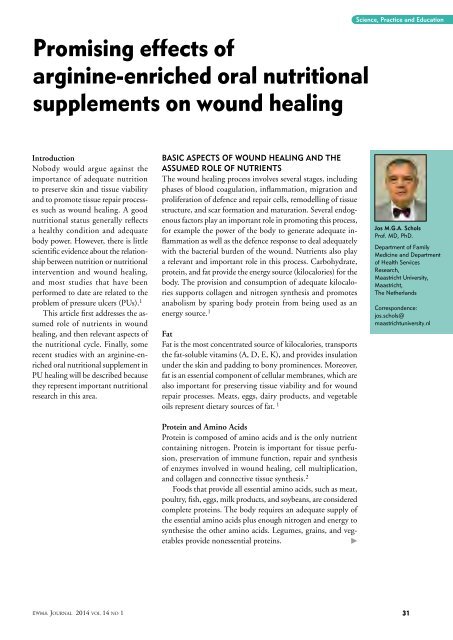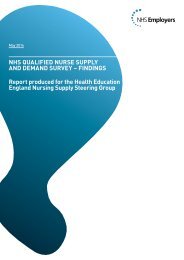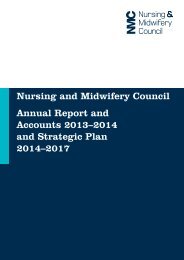Journal_1_2014_final_WEB
Journal_1_2014_final_WEB
Journal_1_2014_final_WEB
You also want an ePaper? Increase the reach of your titles
YUMPU automatically turns print PDFs into web optimized ePapers that Google loves.
Promising effects of<br />
arginine-enriched oral nutritional<br />
supplements on wound healing<br />
Science, Practice and Education<br />
Introduction<br />
Nobody would argue against the<br />
importance of adequate nutrition<br />
to preserve skin and tissue viability<br />
and to promote tissue repair processes<br />
such as wound healing. A good<br />
nutritional status generally reflects<br />
a healthy condition and adequate<br />
body power. However, there is little<br />
scientific evidence about the relationship<br />
between nutrition or nutritional<br />
intervention and wound healing,<br />
and most studies that have been<br />
performed to date are related to the<br />
problem of pressure ulcers (PUs). 1<br />
This article first addresses the assumed<br />
role of nutrients in wound<br />
healing, and then relevant aspects of<br />
the nutritional cycle. Finally, some<br />
recent studies with an arginine-enriched<br />
oral nutritional supplement in<br />
PU healing will be described because<br />
they represent important nutritional<br />
research in this area.<br />
Basic aspects of wound healing and the<br />
assumed role of nutrients<br />
The wound healing process involves several stages, including<br />
phases of blood coagulation, inflammation, migration and<br />
proliferation of defence and repair cells, remodelling of tissue<br />
structure, and scar formation and maturation. Several endogenous<br />
factors play an important role in promoting this process,<br />
for example the power of the body to generate adequate inflammation<br />
as well as the defence response to deal adequately<br />
with the bacterial burden of the wound. Nutrients also play<br />
a relevant and important role in this process. Carbohydrate,<br />
protein, and fat provide the energy source (kilocalories) for the<br />
body. The provision and consumption of adequate kilocalories<br />
supports collagen and nitrogen synthesis and promotes<br />
anabolism by sparing body protein from being used as an<br />
energy source. 1<br />
Fat<br />
Fat is the most concentrated source of kilocalories, transports<br />
the fat-soluble vitamins (A, D, E, K), and provides insulation<br />
under the skin and padding to bony prominences. Moreover,<br />
fat is an essential component of cellular membranes, which are<br />
also important for preserving tissue viability and for wound<br />
repair processes. Meats, eggs, dairy products, and vegetable<br />
oils represent dietary sources of fat. 1<br />
Jos M.G.A. Schols<br />
Prof. MD, PhD.<br />
Department of Family<br />
Medicine and Department<br />
of Health Services<br />
Research,<br />
Maastricht University,<br />
Maastricht,<br />
The Netherlands<br />
Correspondence:<br />
jos.schols@<br />
maastrichtuniversity.nl<br />
Protein and Amino Acids<br />
Protein is composed of amino acids and is the only nutrient<br />
containing nitrogen. Protein is important for tissue perfusion,<br />
preservation of immune function, repair and synthesis<br />
of enzymes involved in wound healing, cell multiplication,<br />
and collagen and connective tissue synthesis. 2<br />
Foods that provide all essential amino acids, such as meat,<br />
poultry, fish, eggs, milk products, and soybeans, are considered<br />
complete proteins. The body requires an adequate supply of<br />
the essential amino acids plus enough nitrogen and energy to<br />
synthesise the other amino acids. Legumes, grains, and vegetables<br />
provide nonessential proteins.<br />
<br />
EWMA <strong>Journal</strong> <strong>2014</strong> vol 14 no 1 31




